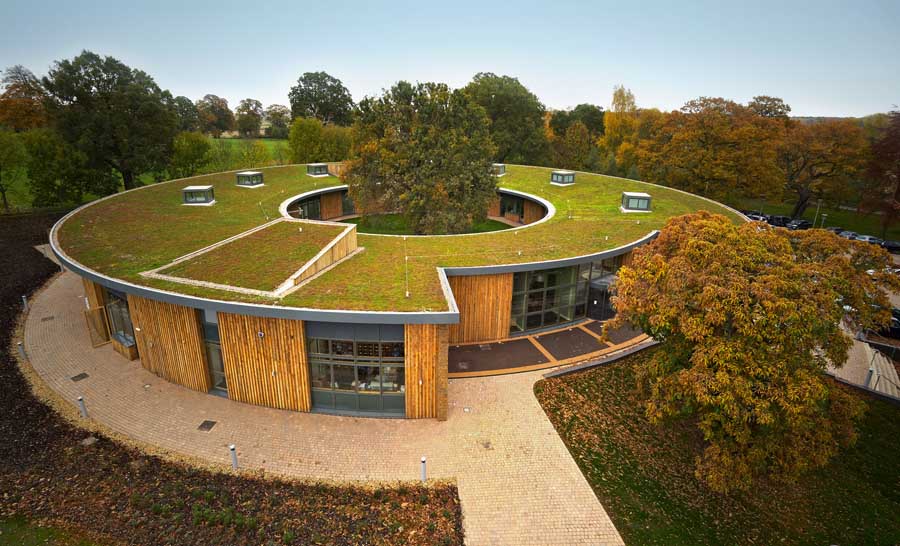The need for green spaces and arable land throughout time has led humankind to create countless technological and architectural marvels. From terraced farming shaped by the Incas in the Andes to the irrigation power of ancient Roman aqueducts, people have always found ways to use existing materials to their advantage. And from the moment we put roofs over our heads, we’ve thought about ways to make them useful.
That’s where sedum roofs come in. A sedum roof is a sustainable building technique that reimagines rooftops as spaces capable of reducing our environmental impact, absorbing rain runoff, and keeping buildings cool. As the construction industry embraces sustainable building decisions, sedum roofing offers several advantages such as lower energy costs, less air pollution, and increased curb (sorry, roof) appeal.
Why Sedum?
Sedum is a large genus of flowering plants often referred to as stonecrops. Most sedums are hardy, drought-resistant succulents that thrive with minimal care and maintenance. They come in a variety of colors and leaf patterns as the genus boasts more than 400 unique species. Sedum is especially appropriate for use in a green roof or other long term project because the plants are fairly lightweight, require little water, and rarely succumb to diseases or insects.
A sedum roof consists of multiple thin layers of material. Underneath a few inches of plants in an engineered growing medium, there is a filtration layer, an excess water drainage layer, and special membranes to prevent moisture or root damage to the structure below.
Sedum roofs are most often installed as a series of interlocking, densely-packed trays that dissuade weeds and erosion. Designing and engineering a series is always a project-specific process, because it depends on a roof’s load capacity, incline, and the variation in weight of the sedum plantings being used.
The Market for Green Roofs Continues to Expand
From urban farms to grassy recreational areas, converting traditional roofs to green spaces is rapidly gaining popularity. The coronavirus pandemic has further demonstrated this growing desire for built environments that prioritize outdoor areas, natural landscapes, and walking trails. Beyond its environmental benefits, a sedum roof offers visitors a break from the monotony of steel, glass, and cement that dominate most cities.
The market for green roofs, including sedum-based systems, was valued at $1.1 billion in 2019, according to research by Grand View Research. The study projects that this number will climb by a steady 17 percent each year from 2020 to 2027 as more people invest in sustainable living.
Sedum Roofs Can Help the Construction Industry Go Green
As housing needs increase and the built environment expands, the construction industry is implementing more sustainable practices in every step of the building process, from sourcing raw construction materials to using geothermal heating and cooling systems. The buildings we live, work, and play in, along with the construction of new ones, account for 40 percent of annual global CO2 emissions, according to reports by Architecture 2030.
Installing sedum roofs is one way to decrease that percentage and ensure buildings remain eco-friendly long after their construction is completed. A sedum roof transforms empty rooftops that radiate heat into green oases, taking advantage of an existing structure to increase local biodiversity, prevent excess rain runoff, and scale back the level of carbon dioxide in the air. Whereas a standard roof can retain 24 percent of rainfall, many green roofs can retain up to 80 percent, significantly easing the strain on nearby sewage systems during storms.
Additionally, the Environmental Protection Agency notes green roofs can help cities combat the Urban Heat Island Effect — restoring green spaces to areas covered by pavement, buildings, and human activity. Currently, the UHI effect causes several concerns in cities like New York, Chicago, and San Francisco, including air pollution, high energy demands, and low quality of living for residents and tourists. The EPA surmises buildings with green roofs are frequently ten or more degrees cooler than those with standard roofs – and that green roofs can simultaneously lower ambient temperatures. In New York City alone, the potential roof space for greening amounts to 20 to 30 times the size of its iconic Central Park, as calculated by Stuart Gaffin, a research scientist at the Center for Climate Systems Research.
Major new builds are already using similar roofs to offset their costs and environmental impact. In the Brooklyn Navy Yard, 23,000 square feet of previously impermeable roofing on Admiral’s Row has been converted into three resplendent green roofs by Steiner Studios. Museums in Denmark and the Netherlands have used local plants to turn their buildings into living art pieces on which visitors can relax and picnic, nestled into the surrounding landscape.
The Future of Sedum Roofs: Sustainability in All Builds
Individuals and businesses located in rural and suburban areas can also benefit from adding a sedum roof, whether an amateur gardener decides to add one to their shed to attract pollinators or a company wants to make their headquarters more visually appealing.
Sedum and other green roofs can improve practically any build, old or new. However, the main barrier to their widespread adoption is the comparative upfront costliness. The price of a traditional residential roof may range from five to ten thousand dollars. Meanwhile, the landscaping expertise, necessary materials, and transportation costs of a sedum roof can cost anywhere from $15,000 to $30,000.
Fortunately, big cities and small towns alike now offer financial grants to contractors, landscapers, and property owners who build green roofs. In some cases, the grants amount to half or all of the costs associated with installation and maintenance. Experts predict that such support from city officials and private investors will encourage a new era in green living, with green roofs at the forefront of that change.

